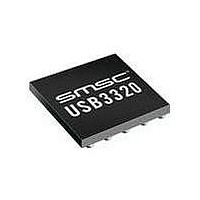USB3300-EZK-TR SMSC, USB3300-EZK-TR Datasheet - Page 51

USB3300-EZK-TR
Manufacturer Part Number
USB3300-EZK-TR
Description
USB Interface IC USB 2.0 PHY ULPI
Manufacturer
SMSC
Type
Hi Speed USB Host Devicer
Datasheet
1.USB3300-EZK.pdf
(55 pages)
Specifications of USB3300-EZK-TR
Maximum Operating Temperature
+ 85 C
Minimum Operating Temperature
- 40 C
Mounting Style
SMD/SMT
Operating Temperature Range
- 40 C to + 85 C
Operating Supply Voltage
3.3 V
Package / Case
QFN-32
Lead Free Status / RoHS Status
Lead free / RoHS Compliant
Available stocks
Company
Part Number
Manufacturer
Quantity
Price
Company:
Part Number:
USB3300-EZK-TR
Manufacturer:
MICRON
Quantity:
3 140
Part Number:
USB3300-EZK-TR
Manufacturer:
MICROCHIP/微芯
Quantity:
20 000
Hi-Speed USB Host, Device or OTG PHY with ULPI Low Pin Interface
Datasheet
SMSC USB3300
7.4.1
7.4.2
7.4.2.1
7.4.2.2
Human Body Model (HBM) Performance
HBM testing verifies the ability to withstand the ESD strikes like those that occur during handling and
manufacturing, and is done without power applied to the IC. To pass the test, the device must have
no change in operation or performance due to the event. All pins on the USB3300 provide
protection.
IEC61000-4-2 Performance
The IEC61000-4-2 ESD specification is an international standard that addresses system-level immunity
to ESD strikes while the end equipment is operational. In contrast, the HBM ESD tests are performed
at the device level with the device powered down.
SMSC contracts with independent laboratories to test the USB3300 to IEC61000-4-2 in a working
system. Reports are available upon request. Please contact your SMSC representative, and request
information on 3rd party ESD test results. The reports show that systems designed with the USB3300
can safely dissipate ±15kV air discharges and ±8kV contact discharges per the IEC61000-4-2
specification without additional board level protection.
Both air discharge and contact discharge test techniques for applying stress conditions are defined by
the IEC61000-4-2 ESD document.
Air Discharge
To perform this test, a charged electrode is moved close to the system being tested until a spark is
generated. This test is difficult to reproduce because the discharge is influenced by such factors as
humidity, the speed of approach of the electrode, and construction of the test equipment.
Contact Discharge
The uncharged electrode first contacts the pin to prepare this test, and then the probe tip is energized.
This yields more repeatable results, and is the preferred test method. The independent test laboratories
contracted by SMSC provide test results for both types of discharge methods.
DATASHEET
51
Revision 1.08 (11-07-07)
±
8kV HBM







